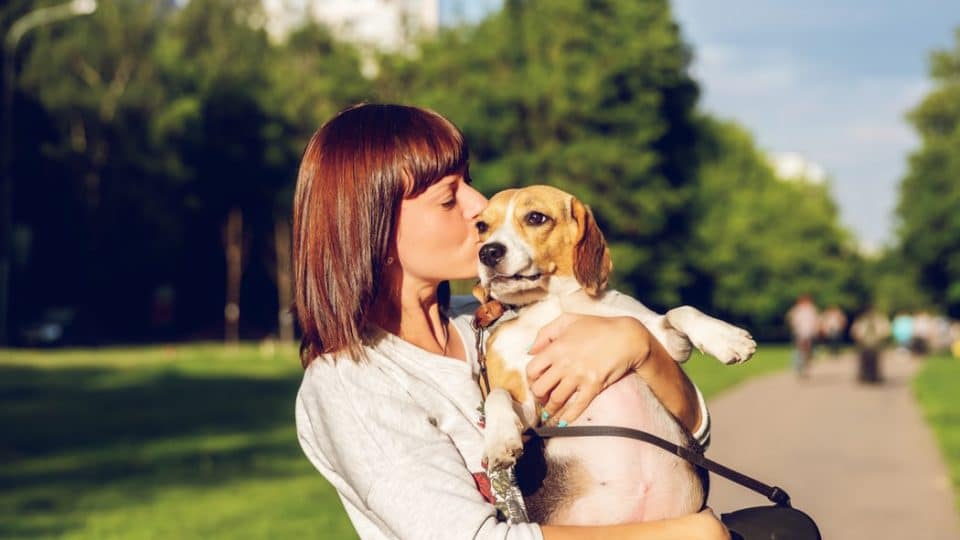You may know how to tell if your dog loves you, but do you know how to tell your dog you love them back?
Often, the best way to tell a dog you love them is through mimicry. Dogs rely on facial expressions and whole body language to communicate. The better you understand canine communication and how your dog feels, the better you’ll be able to empathise and bond with them, expressing your love right back at them.
Additionally, dogs are descended from pack animals (though there’s still heated debate as to whether they can still be classified as such). Because of residual genetic or evolutionary pack animal inheritance, from times long before domestication, dogs enjoy the connections made from being part of a pack:
- hunting (which we often mimic with play, think retrieving a ball or ripping into a squeaky toy)
- exercising (part of the hunting and scavenging behaviour of a pack)
- physical touch (if only we could recreate the den in our modern living rooms)
By learning to interpret dog body language and mimic the pack behaviours your dog craves, you can say ‘I love you’ to your dog in the following ways—because we all know that a loved dog equals a happy dog.
1. Don’t be embarrassed to use your dog voice
https://www.instagram.com/p/BvFynF-nPjL/
Studies using MRI technology show dogs understand human language better than previously thought. So holding that one-way conversation with your dog isn’t as crazy as you might think.
The news gets better: that high-pitched tone you use to talk to your dog (better known as baby-talk)? Dogs actually like it. Medical News Today also points out that your dog wants to hear words specific to the dog lexicon: treat, walk, good. You know the words.
Also, reading to dogs has been shown to calm anxious and high-energy dogs in shelters, and brings shy dogs out of their shells.
2. Be a good listener
Not sure if you’re getting the message of love across? Your dog’s body language will tell you. Look for all of the dog body languages of love:
- a wagging tail
- eye contact
- a raised eyebrow (see more below)
Conversely, keep an eye out for the warning signs of and anxious dog:
- a tucked tail
- lip licking
- your dog’s eyes are popping out or averted
https://www.instagram.com/p/Bs3VX5_nh3V/
3. Loving gazes
Your dog’s eyes do much of their talking. You can communicate back to them using the same language of eye contact.
When a dog gives you long, lingering eye contact, it’s a way of saying “I love you.” A recent study shows that oxytocin, the ‘love chemical,’ goes up in both dogs and humans when they share a kind gaze.
Watch your approach, though. Staring down a dog in a forceful manner can be a sign of aggression for your dog.
4. Facial expressions of love
No matter how we may wish to hide our feelings, even from our dogs, most pet owners know that animals are sensitive to our emotional states. Scientific studies have shown that dogs can read human emotions through our facial expressions.
You can be intentional about what your face is telling your dog. Japanese behavioural scientists have shown that when a dog feels connected to someone, they often raise their eyebrows—the left one more than the right. So greeting your dog with raised eyebrows and a relaxed smile tells your dog how happy you are to see them.
5. The lean of love
https://www.instagram.com/p/2So7CeNLir/?utm_source=ig_embed
Did you know that a dog will lean against you as a sign of love and trust? Unless the lean seems to be an anxious behaviour or a not-so-subtle push toward the door, this body posture from your dog can be mimicked or reciprocated to show affection.
So go ahead, lean in to show a little love.
6. Cuddles and naps
https://www.instagram.com/p/BrRHUa0n9Vw/
Part of your dog’s aforementioned residual pack behaviour is playing hard and then resting together. Even if you don’t care to let your dog in bed with you, an afternoon nap together on the couch or in the grass will deepen your dog’s feeling of a pack connection.
And like humans, dogs thrive on physical contact. So while your dog may not enjoy a hug, a nice cuddle session offers the connection they crave.
7. Strolling
https://www.instagram.com/p/BRlr9o3hWDy/
Dogs thrive on routine and schedule, so a daily walk with training mixed in will help your dog understand how much you love and care for them.
Walks and adventures give plenty of opportunities to work on skills like loose-lead walking and recall. These shared experiences and training sessions build trust, communication, and that pack connection.
8. The touch of love
Just touching your dog releases oxytocin in you and your dog, so a soothing massage, gentle grooming session, or extended patting time will tell your dog in no uncertain terms how much you love them. In particular, rubbing your dog’s ears works to release oxytocin in their body. Those adorable, soft ears are also packed with feeling receptors.
https://www.instagram.com/p/BqH1JrFhJd3/
Human signals of affection that may not translate to dogs
Dog owners also benefit from learning which human signs showing affection make no sense to your dog.
- Hugging: some dogs feel trapped or pinned down when you hug them. Watch your dog’s reaction.
- Kissing: a quick peck on the head is remarkably similar to a playful nip on the neck or a gesture of domination. Your dog may think you’re trying to play or assert your place in the household hierarchy.
- Treats: as much as food can be a sign of affection for humans, treats are best used for motivating behaviour and dog training. Think of how quickly your dog’s loyalty disappears the minute someone else offers them treats.
Your canine languages of love
Learning to say, “I love you” to your dog is a simple matter of getting to know both your dog’s individual body language as well as those comforts of pack life that your dog’s animal brain still craves. As a bonus, all of these love languages seem to benefit your sense of well-being, too. For even more ways to improve your relationship with your dog, check out what Emma Reed has to say.
___
Featured image: Ragnar the Red Husky




